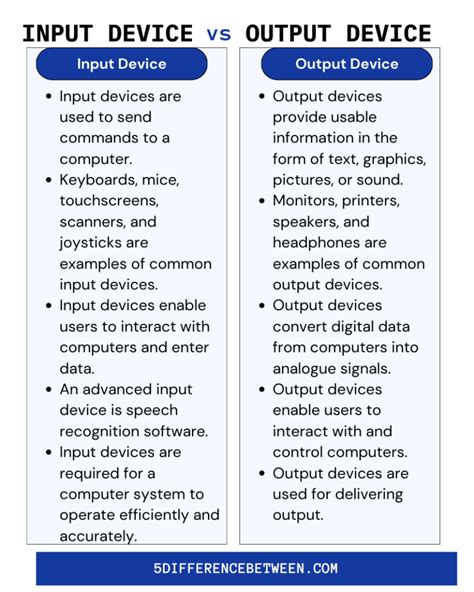

Input vs Output Devices: Ultimate Guide 2025
Definition
Input Devices: Devices that allow users to interact with and provide data or signals to a computer system. Examples include keyboards, mice, and scanners.

Output Devices: Devices that display or communicate information from a computer system. Examples include monitors, printers, and speakers.
Functionality and Characteristics
Input Devices
- Function: Collect and relay data or signals to the computer.
-
Characteristics:
- Types: Keyboards, mice, touchscreens, scanners, microphones.
- Data Source: User inputs, physical actions, external signals.
- Output: Digital signals representing data or commands.
Output Devices
- Function: Display or convey information processed by the computer.
-
Characteristics:
- Types: Monitors, printers, speakers, projectors.
- Output Format: Visual, auditory, or physical form.
- Input: Digital signals received from the computer.
Table 1: Common Input and Output Devices
| Input Device | Function |
|---|---|
| Keyboard | Text and command input |
| Mouse | Pointing and clicking |
| Touchscreen | Gesture and multi-touch input |
| Scanner | Digitizing physical documents |
| Microphone | Audio input |
| Output Device | Function |
|---|---|
| Monitor | Displaying visual information |
| Printer | Creating physical copies of documents or images |
| Speakers | Generating audio output |
| Projector | Displaying large-scale images or presentations |
Table 2: Differences Between Input and Output Devices
| Feature | Input Devices | Output Devices |
|---|---|---|
| Primary Function | Data input | Information display/output |
| Data Flow | Inbound | Outbound |
| User Interaction | Active (requires user input) | Passive (displays information) |
| Variety of Types | Wide range (keyboards, mice, etc.) | Limited range (monitors, printers, etc.) |
| Input/Output | Input to the computer | Output from the computer |
Applications and Use Cases
Input Devices
- Data entry: keyboards, scanners
- Human-computer interaction: mice, touchscreens
- Creative expression: drawing tablets, musical instruments
- Data collection: sensors, medical devices
Output Devices
- Visual presentation: monitors, projectors
- Printed documents: printers
- Audio feedback: speakers, headphones
- Control and feedback: actuators, displays
Emerging Trends and Innovations
Input Devices
- Haptic feedback: Providing tactile sensations through input devices.
- Gesture recognition: Identifying and interpreting hand and body gestures.
- Biosensors: Utilizing biological signals (e.g., EEG, ECG) for input.
- Brain-computer interfaces: Connecting the brain directly to input devices for enhanced control.
Output Devices
- Virtual and augmented reality: Creating immersive visual experiences.
- 3D printing: Producing physical objects from digital models.
- Flexible displays: Screens that can bend and fold for portable use.
- Wearable technologies: Output devices integrated into clothing or accessories.
Case Study: Enhancing Healthcare with Input/Output Devices
In the healthcare industry, both input and output devices play crucial roles in improving patient care and efficiency. For example:
-
Input Devices:
- Patient monitoring devices collect physiological data and relay it to the computer system.
- Touchscreens allow doctors and nurses to access patient records and make real-time decisions.
-
Output Devices:
- Monitors display patient data, images, and test results.
- Printers generate physical reports and prescriptions.
- Speakers provide audio alerts and notifications.
Conclusion
Input and output devices are essential components of computer systems, enabling users to communicate with and receive information from computers. As technology advances, these devices continue to innovate, offering new possibilities for human-computer interaction and enhanced user experiences.










